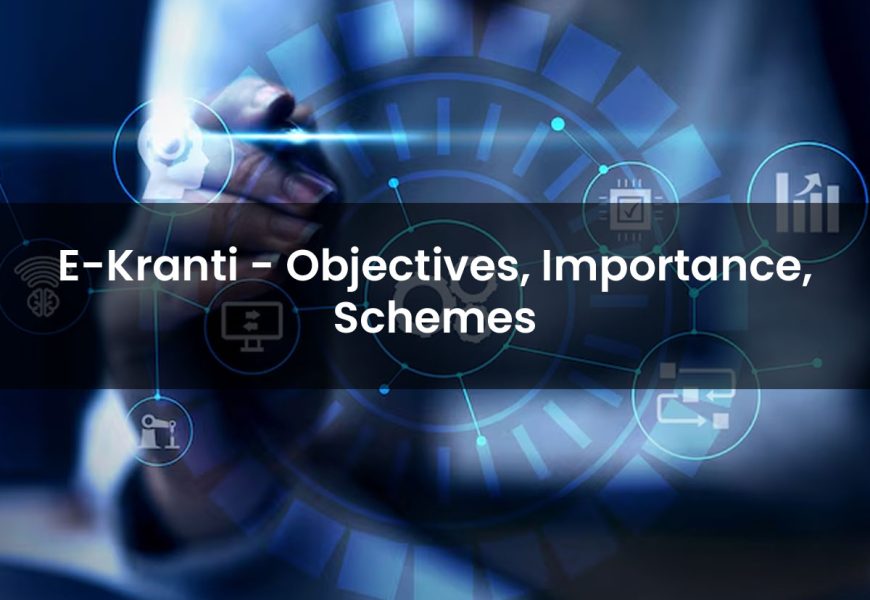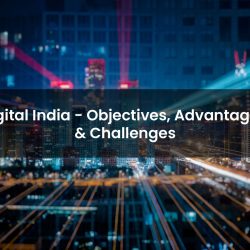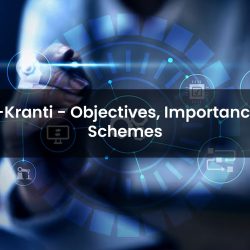The e-Kranti: National e-Governance Plan (NeGP) is an integral part of the Digital India Programme, aimed at transforming the delivery of government services through digital means. Implemented by the Department of Electronics and Information Technology (DeitY), e-Kranti is essential for enhancing e-governance, streamlining governance processes, and promoting good governance across the country.
This article aims to shed light on the inception, objectives, and schemes taken under e-Kranti.
What is E-Kranti?
E-Kranti, an integral part of the Indian government’s Digital India project, prioritises transforming India into a digital society and knowledge economy. This initiative encompasses e-government, technology-driven government reform, and the provision of e-services, all under the National E-government Program (NEGP). E-Kranti is pivotal for digital technology in India, ensuring effective e-government, convenient management, and good governance. Approved by the ITU Cabinet on March 25, 2015, e-Kranti’s approach includes its vision, mission, key principles, methods, planned management structure, and implementation strategies, featuring 44 mission mode projects and essential ICT infrastructure.
The vision of e-Kranti is not just about digital transformation, but about transforming governance through e-government. Its mission is not just about providing public services electronically, but about doing so through a multi-mode integrated and interoperable system. This comprehensive approach aims to transform the entire government, ensuring efficiency, transparency, and reliability. Additionally, these services are not just about being available, but about being reasonably priced.
Components of E-Kranti
Digital India comprises three main components: the safe and stable development of digital infrastructure, the provision of public services in digital form, and universal digital capabilities. E-Kranti leverages these components to enhance governance through technology-driven reforms and e-services.
Digital India serves as both a tool and a beneficiary of other significant government programs, such as Bharat Mala, Sagarmala, Dedicated Freight Corridor, Industrial Corridor, UDAN-RCS, Bharat Net, and Make in India. By connecting rural areas through high-speed Internet networks and improving digital literacy, e-Kranti ensures that public services are accessible to all citizens electronically. This comprehensive approach promotes the overall transformation of government operations, enhancing efficiency, transparency, and reliability.
Objectives of E-Kranti
- e-Kranti aims to revamp the National e-Governance Plan (NeGP) by focusing on transformative and result-oriented e-Governance projects. This involves shifting from traditional approaches to more innovative and effective methods of governance.
- The initiative seeks to fulfil the vision of the Digital India Programme, which aspires to transform India into a digitally empowered society and knowledge economy.
- E-Kranti intends to broaden the range of government services available to citizens. This includes developing and deploying new e-Governance applications that meet the population’s diverse needs.
- By employing core ICT infrastructure and resources efficiently, e-Kranti aims to maximise the impact and reach of e-Governance services. This involves utilising existing technology infrastructure to its full potential.
- The initiative focuses on the swift replication and seamless integration of successful e-Governance applications across different regions and departments. This helps in scaling up successful projects and ensuring uniform service delivery.
- E-Kranti encourages the adoption of cutting-edge technologies to enhance the efficiency, transparency, and effectiveness of government services. This includes integrating new innovations like cloud computing, big data, and mobile technologies.
- The initiative advocates for agile and flexible implementation strategies that can quickly adapt to changing requirements and technological advancements. This approach aims to reduce project delays and improve responsiveness.
- To stay relevant and effective, e-Kranti focuses on continuously updating and upgrading e-Governance systems. This involves regular assessment and incorporation of the latest technologies and practices to prevent technological obsolescence.
Principles Of E-Kranti
Based on the experience with the National E-Governance Plan (NeGP) and the preceding analysis, a set of principles has been proposed to guide the design and implementation of the e-Kranti Program:
Transformation, Not Translation
Any project proposal included in e-Kranti must demonstrate a substantial transformation in the quality, quantity, and manner of service delivery or a significant enhancement in productivity and competitiveness.
Each proposal should be accompanied by a statement detailing necessary changes in laws and regulations or the intention to introduce new legislation to ensure the legal sustainability of the proposed transformation.
If the degree of transformation in already implemented or ongoing Mission Mode Projects (MMPs) is inadequate, these projects should undergo necessary changes to enhance their scope and impact.
Transformation can take various forms, including significant process changes, revamping delivery points with a new look and feel, setting predefined service levels, introducing technology in innovative ways, abolishing manual systems, implementing self-financing business models for financial sustainability, and adopting innovative models for service delivery.
Integrated Services, Not Individual Services
Many e-Governance projects, both within and outside the National E-Governance Plan (NeGP), have traditionally focused on services from the perspective of individual departments or agencies. This approach often results in citizens or businesses having to secure multiple certificates and documents, many from authorities outside the department providing the particular e-Service, to complete an application.
The solution lies in designing and implementing integrated, cross-cutting services. The eBiz project, which aimed to provide such services, faced numerous implementation challenges due to a lack of shared conviction about the benefits of integration. Despite these challenges, significant progress has been in integrating front-end delivery points for citizen services, inspired by the eSeva initiative implemented in Andhra Pradesh between 1999 and 2003. This model has since been adopted by various states.
However, the current need is to establish a common middleware and integrate back-end processes and systems. Providing integrated services on an end-to-end basis should be the unique selling proposition (USP) and hallmark of e-Kranti. The extensive and possibly mandatory use of Unique ID for resident identification and the e-Pramaan framework developed by DeitY for individual authentication is recommended to achieve this. This approach ensures seamless service delivery, enhancing efficiency and user experience.
Mandatory Government Process Re-engineering (GPR) for Every MMP
One criticism of the National E-Governance Plan (NeGP) is the insufficient focus on process reengineering. This results in citizens having to navigate several unnecessary preliminary steps and make multiple trips to service centres before their requests are fulfilled. This process contains many non-value adds (NVAs). Therefore, Government Process Reengineering (GPR) is essential for e-Kranti.
Infrastructure on Demand
A significant portion of government departments’ and ministries’ efforts is currently dedicated to designing, procuring, and establishing various types of information infrastructure, such as data centers with their own hardware and software, redundant networks, and other software platforms. However, as emphasized earlier, these energies could be better spent focusing on transforming service delivery.
Recent technological advancements make achieving ‘Infrastructure on Demand’ possible. The National Optical Fibre Network project, undertaken by the Department of Telecommunications, Government of India, promises to resolve connectivity issues by bringing gigabit fibre to villages. However, this addresses only part of the broader goal of establishing on-demand infrastructure.
To fully realise this vision, the National Information Infrastructure (NII) initiative, spearheaded by DeitY and currently at an advanced stage of conceptualisation, needs to be fast-tracked and seriously considered for acceptance, approval, and implementation. This initiative aims to provide a scalable and flexible infrastructure that departments and ministries can utilise as needed, allowing them to concentrate on enhancing service delivery rather than managing infrastructure.
Infrastructure on Demand
Government departments and ministries often expend significant efforts on designing, procuring, and establishing various types of information infrastructure, such as data centres, networks, and software platforms. Instead, they should focus on transforming service delivery. This can be achieved through ‘Infrastructure on Demand,’ leveraging recent technological advancements. The National Optical Fibre Network project by the Department of Telecommunications aims to bring gigabit fibre to villages, addressing connectivity issues as part of a larger vision of on-demand infrastructure. The National Information Infrastructure (NII) initiative by DeitY, currently in advanced conceptual stages, needs to be fast-tracked for acceptance, approval, and implementation.
Cloud by Default
Cloud technologies offer flexibility, agility, cost-effectiveness, and transparency. Government Cloud shall be the default for government departments, with private cloud usage requiring permission from the Department of Electronics and Information Technology (DeitY), based on security and privacy assessments. The National Cloud Computing Initiative, Meghraj, launched by NIC, should be evaluated, strengthened, and expanded. Establishing an eGov App Store with successful applications for immediate adoption by departments will prevent reinventing the wheel. This should be complemented by an eGov Application Directory and an eGov Services Directory, based on Service-Oriented Architecture (SoA) standards, to streamline project implementation.
Mobile First
The Mobile Seva project has seen immense success, with mobile access becoming the default option for information and services. Given the proliferation of low-cost handsets, smartphones, and tablets, applications should be designed or redesigned to prioritise mobile delivery.
Fast Tracking Approvals
E-Governance projects often face delays due to procedural constraints. A special code of financial procedures tailored for e-Governance projects is advisable. To expedite project initiation, a standard system for fast-track consultancy assignments from pre-qualified firms should be established. Once a Detailed Project Report (DPR) is approved, an Empowered Committee should take subsequent decisions promptly. Well-implemented e-governance projects, which enhance productivity, efficiency, and transparency, should be exempt from budgetary restrictions to ensure timely implementation.
Mandating Standards and Protocols
DeitY’s current standards, issued through executive orders, lack statutory value. A special set of rules under the proposed EDS Bill should regulate and mandate these standards, including generic standards by DeitY and domain-specific standards by line ministries. An Institute for e-Gov Standards should oversee this task. Reference Architecture Models incorporating cutting-edge technologies and standards-based middleware infrastructure should be established to promote interoperability. Senior architects and CIOs should stay updated on technology trends.
National GIS
The National GIS (NGIS) should be leveraged as both a platform and a service for various mission mode projects and e-Governance initiatives, including monitoring the physical progress of projects.
Security and Electronic Data Preservation
Online applications and e-services must adhere to prescribed security measures, including those outlined in the National Cyber Security Policy 2013 by DeitY. The increasing computerisation and adoption of e-governance necessitate preserving electronic data and records for future reference. The E-Governance Standard for Preservation Information Documentation of Electronic Records by DeitY should be followed to ensure proper data preservation.
Focus Areas of E-Kranti
e-Education
- Broadband Connectivity for Schools: All schools across India will be connected to broadband internet, ensuring access to digital resources and educational content.
- Free WiFi in Secondary and Higher Secondary Schools: Free WiFi will be provided in approximately 250,000 secondary and higher secondary schools, enabling students and teachers to benefit from seamless internet access for educational purposes.
PMGDISHA (Pradhan Mantri Gramin Digital Saksharta Abhiyaan)
Digital Literacy for Rural India: This initiative aims to make six crore people in rural India digitally literate, empowering them with the knowledge and skills to use digital devices and the internet effectively.
SWAYAM (Study Webs of Active Learning for Young Aspiring Minds)
Massive Open Online Courses (MOOCs): SWAYAM provides a platform for hosting courses that are taught in classrooms from Class 9 to post-graduation. These courses can be accessed by anyone, anywhere, at any time, promoting inclusive and widespread access to quality education.
e-Healthcare
- Online Medical Consultation: Patients can consult with doctors and healthcare professionals online, reducing the need for physical visits and making healthcare more accessible.
- Online Medical Records: Medical records will be digitized and made accessible online, ensuring that patient information is available whenever and wherever needed.
- Online Medicine Supply: Medicines can be ordered online, making it easier for patients to receive their medications on time.
- Pan-India Patient Information Exchange: A nationwide system will facilitate the exchange of patient information across different healthcare providers, enhancing the continuity and quality of care.
Support for Farmers
- Real-time Price Information: Farmers will have access to real-time market prices for their produce, helping them make informed decisions.
- Online Ordering of Inputs: Inputs such as seeds, fertilizers, and equipment can be ordered online, streamlining the supply chain and reducing costs.
- Online Cash, Loan, and Relief Payments with Mobile Banking: Financial transactions, including cash payments, loans, and relief payments, will be facilitated through mobile banking, ensuring timely and efficient financial support for farmers.
Security
Mobile-based Emergency and Disaster Services: Real-time mobile-based services will be provided for emergency situations and disaster management, enabling citizens to take precautionary measures and minimise the loss of lives and property.
Financial Inclusion
Strengthening Financial Inclusion: Mobile banking, the Micro-ATM program, and the utilisation of CSCs (Common Service Centers) and Post Offices will enhance financial inclusion, bringing banking services to underserved areas.
Justice
Interoperable Criminal Justice System: The criminal justice system will be strengthened through the integration of various related applications, including e-Courts, e-Police, e-Jails, and e-Prosecution, ensuring a more efficient and cohesive judicial process.
Planning
National GIS Mission Mode Project: This project will facilitate GIS-based decision-making for project planning, conceptualisation, design, and development, enhancing the accuracy and effectiveness of government planning initiatives.
Cyber Security
National Cyber Security Co-ordination Centre: Established to ensure a safe and secure cyberspace within the country, this centre will monitor and respond to cyber threats, protecting the nation’s digital infrastructure.
Mission Modes
Under the e-Kranti initiative, various Mission Mode Projects (MMP) are categorised into Central, State, and Integrated projects. These projects aim to streamline and enhance specific areas of governance across different levels of administration.
Central Mission Mode Projects
- Income Tax
- Passport
- MCA21 (Ministry of Corporate Affairs)
- Insurance
- National Citizen Database
- Central Excise
- Pensions
- Banking
- e-Office
- Posts
- Visa and Immigration
- E-Sansad
- Common IT Roadmap for Para Military Forces
State Mission Mode Projects
- Land Records
- Road Transport
- Property Registration
- Agriculture
- Treasuries
- Municipalities
- Gram Panchayats
- Commercial Taxes
- Police
- Employment Exchanges
- School Education
- Health
- Public Distribution System (PDS)
- E-Vidhaan
- Rural Development
- Women and Child Development
Integrated Mission Mode Projects
- EDI (E-Commerce)
- E-Bitz
- Common Services Centres
- India Portal
- E-Courts
- E-Procurement
- National Service Delivery Gateway
- Financial Inclusion
- National Geographical Information System
- Social Benefits
- Roads and Highways Information System (RAHI)
- E-Bhasha
- National Mission on Education Through ICT (NMEICT)
- Urban Governance
These Mission Mode Projects are designed to address specific challenges and improve service delivery in key areas of governance, ranging from taxation and public administration to education, healthcare, and rural development.
FAQs on E-Kranti
When was e-kranti launched?
The Union Cabinet approved the approach and key components of e-Kranti on March 25, 2015. This initiative was introduced to address the critical need for e-governance, mobile Governance, and Good Governance in the country.
What are the 9 pillars of e-kranti?
The nine pillars of e-Kranti are:
- Broadband Highways
- Universal Access to Mobile Connectivity
- Public Internet Access Program
- E-Governance
- E-Kranti
- Electronics Manufacturing
- IT for Jobs
- Early Harvest Programs
- Information for All
Who introduced e-Governance in India?
The concept of e-Governance was introduced in India by the National Informatics Centre (NIC), established in 1977. The Department of Electronics, formed in 1970, laid the foundation for electronic governance, with initiatives like the District Information System program aimed at computerising district offices nationwide.















